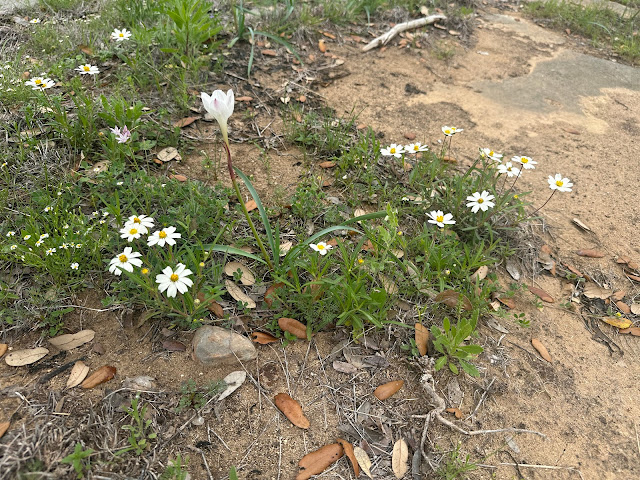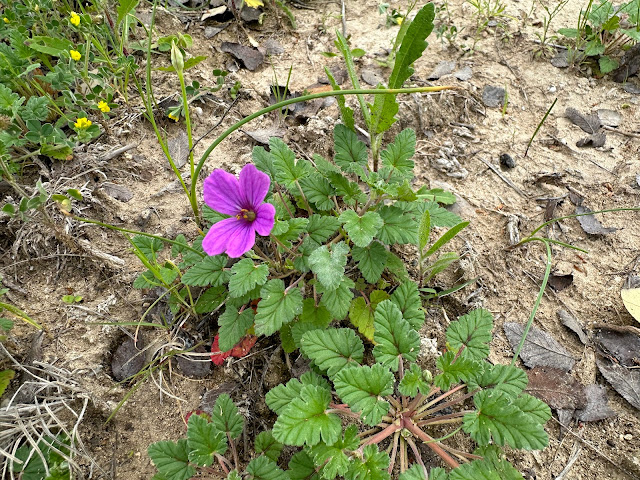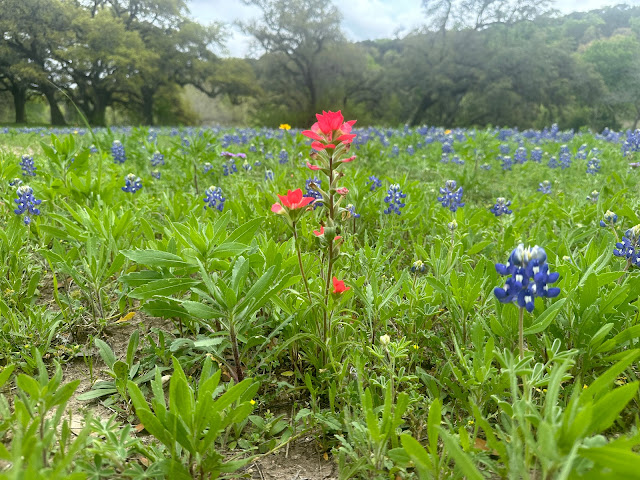I think I first heard of gluten-intolerance 18 years ago. And now it's on tiles at a Mexican restaurant in Austin. Not just ANY restaurant: the Fonda de San Miguel!
This was the justification for my trip: I wanted to introduce my very cool friends in the Austin area to my very cool daughter, Eleni (lower right)...and we enjoyed a wonderful dinner--much of it subsidized by a dear friend from San Marcos who was gifted a generous certificate to this restaurant from a good customer. Thank you Patrick! Thank you customer!
The next day we had the extraordinary opportunity to visit a private ranch in the Hill country, guided by Matt above, whose telling us about the 150 year old SECOND growth bald cypress...wonder what the original trees were like!?
 |
| Salvia roemeriana |
Cedar sage was blooming here or there. I have a weakness for Salvia and the color red. I took a lot of pictures!
And, oh yes. I like ferns.
Dryopteris kunthii (a new one for me). I'd like to try this in Denver!
Never found a good angle on
Myriopteris (formerly
Cheilanthes) alabamensis...
Another great novelty for me:
Argyrochrosma dealbata: cousin to our local
A. fendleri--love 'em
both!
Still trying to photograph the
Myriopteris/Cheilanthes...
I was delighted to find
Aesculus pavia in the wild for the first time.
My idea of a great birthday: meet a lot of wonderful horticulturists and explore a new area rich in unfamiliar plants!
Many of the buckeyes were hybrids: this one
A. x bushii--cross between
Aesculus pavia and Ohio buckeye (
A. glabra). This locality doesn't show up on the BONAP maps!
Much of the canyon was festooned with Venus hair fern (
Adiantum capillus-veneris). This form has been called var.
modestum, which I first found in Tecolote Canyon in Baca County nearly a half century ago--a Colorado State record!
This is exactly what it looks like in Tecolote canyon!
 |
| Nolina texana |
Here and there along the canyon long wreaths of hair-like foliage was suspended--rather like Rapunzel's hair!
I was astonished to see that it was a Nolina--in full bloom. We have a very similar (possibly identical) taxon in Colorado that's been reclassified as
N. greenei. I wonder if their not the same thing, only growing in different habitats? I was surprised my
Nolina greenei thrives in rather deep shade of a Ponderosa Pine, blooming prolifically every year...now I see they can grow in shade in the wild.
More
Dryopteris kunthii...so cool to find more of this!
 |
| Rubus trivialis |
I was delighted to find this little dewberry, which was relatively common in moist, shady sites. Apparently the fruit is pretty tasty. I think Michaux was cruel naming it thus--it was not the least bit trivial in my book.
 |
| Mahonia swazeyi |
Another first for me! I have seen six or seven species of our native
Mahonias (or
Berberis for sticklers--since
Berberis HAVE sticklers), this is one we've grown for years at DBG--so fun to see it in the wild!
 |
| Salvia roemeriana |
Obiously dwarfed by growing on rock--how wonderful it would be to have a Cedar sage that grew that compactly in a rock garden!
Zephyranthes drummondii peering over a cliff. Alas, I have not had these persist in Denver, even from plants sourced at the north end of their range.
And of course bluebonnets...
They make a wonderful combo with the rain lilies...
A slightly better shot of
Argyrochrosma dealbata...
 |
| Lithospermum incisum |
This is common throughout Colorado as well, but ours probably won't come into bloom for a month or two. The season is much longer down here.
 |
| Melampodium cinereum |
Or possibly M. leucanthum: both are listed in my new Flora of Texas--this has been in bud in my garden for weeks already!
 |
| Erodium texanum |
A winter annual, alas! Would that it would tolerate our subzero winters?
 |
| Anemone berlandieri |
I just realized I never got a picture of the local specialty--Anemone edwardsiana--and I did poorly by its commoner blue cousin. I guess I gotta go back!
 |
| DYC |
I was hiking with a dozen or more experts on native plants including the author of my favorite Texas flora--you'd think I'd have asked one of them for the I.D. of this!
 |
| Chamaesaracha conioides |
I was rather charmed by this little nightshade.
 |
| Castilleja indivisa |
 |
| Lupinus texensis white form |
Bluebonnets everywhere...and of course one photographs the pallid white one...
 |
| Nemastylis geminiflora |
the first we found. Thought it was an
Alophia at first: more about this later...
 |
| Echinocereus reichenbachii |
Just a week or less before this will bloom: this is quite abundant in Texas (and Colorado--where developments haven't obliterated it that is). Surely one of the greatest wildflowers in America: you can even grow it indoors!
 |
| Jeff Pavlat and cacti |
It was a treat to spend time with Jeff--horticulturist who oversees the cactus collection at Zilker Gardens in Austin (which I regret not visiting this time). He'd hosted me on a previous visit almost 10 years ago--he is a force to be reckoned with!
 |
| Rubus trivialis (again) |
I have a weak spot for raspberries...especially little trailers like this (without spines!)
 |
| Nemastylis geminiflora |
I have a lifetime's drama surrounding this--one of America's greatest (and least known) wildflowers. I obtained it in the 1980's from Don Hackenberry and grew it well for years at Denver Botanic Gardens before eventually losing it (don't ask, sad story). I've tried it again recently (one nursery sells it mail order--but it sells out right away). I was taken by Larry Vickerman to where it grows in Kansas--where we'd just missing it blooming. And on my superannuated birthday, I found it in bloom in the wild! This form looks a tad lie
N. tenuis that grows hundreds of miles further West--more mysteries to unravel.
 |
| Love this bumper sticker on the truck of Texas' premier botanist. |
I end with another tile in the bathroom of La Fonda de San Miguel: springtime in the hill country truly pierces to the heart with floral beauty! Not to mention friends and family.



.JPG)




.JPG)
.JPG)
.JPG)
.JPG)
.JPG)
.JPG)
.JPG)
.JPG)
.JPG)

.JPG)
.JPG)











.JPG)
.JPG)
.JPG)





















































